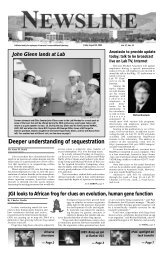NEWSLINE - Lawrence Livermore National Laboratory
NEWSLINE - Lawrence Livermore National Laboratory
NEWSLINE - Lawrence Livermore National Laboratory
You also want an ePaper? Increase the reach of your titles
YUMPU automatically turns print PDFs into web optimized ePapers that Google loves.
4 <strong>NEWSLINE</strong><br />
June 15, 2007<br />
SCIENCE NEWS<br />
Making proton therapy more accessible to cancer patients<br />
By Claudia Morain<br />
UC Davis News Service<br />
With a technology transfer<br />
agreement announced Thursday, the<br />
first compact proton therapy system<br />
— one that would fit in any major<br />
cancer center and cost a fifth as much<br />
as a full-scale machine — is one step<br />
closer to reality.<br />
Proton therapy is considered<br />
the most advanced form of radiation<br />
therapy available, but size and cost<br />
have limited the technology’s use to<br />
only six cancer centers nationwide.<br />
The result of defense-related<br />
research, the compact system<br />
was developed by scientists at the<br />
<strong>Laboratory</strong> in a project jointly funded<br />
by the Lab and UC Davis Cancer<br />
Center. In the new technology<br />
transfer pact, LLNL has licensed<br />
the technology to TomoTherapy<br />
Incorporated (NASDAQ: TTPY) of<br />
Madison, Wis., through an agreement<br />
with the Regents of the University of<br />
California.<br />
TomoTherapy will fund<br />
development of the first clinical<br />
prototype, which will be tested on<br />
patients at UC Davis Cancer Center.<br />
If clinical testing is successful,<br />
TomoTherapy will bring the machines to market.<br />
“We are very pleased that the basic research of our<br />
department’s defense scientists also may serve the nation<br />
by helping to make proton therapy more available to<br />
cancer patients,” said Raymond Orbach, the Department<br />
of Energy’s under secretary for Science.<br />
“This technology has grown out of work to develop<br />
compact, high-current accelerators as flash X-ray<br />
radiography sources for nuclear weapons stockpile<br />
stewardship,” said George Caporaso, the lead scientist<br />
on the project at the <strong>Laboratory</strong>. “We are excited about<br />
applying this new technology to the field of cancer<br />
treatment, to make proton therapy widely available as a<br />
treatment option.”<br />
“We have taken proton therapy and achieved major<br />
advances toward what we were told was impossible — to<br />
scale it down to a size and price that will bring it in reach<br />
of every major cancer center,” said Ralph deVere White,<br />
director of the UC Davis Cancer Center and associate<br />
dean for cancer programs. “Our research partnership<br />
with <strong>Lawrence</strong> <strong>Livermore</strong> <strong>National</strong> <strong>Laboratory</strong> has<br />
fulfilled the mission for which it was created: to deliver<br />
translational research in order to advance health care.”<br />
Conventional radiation therapy kills cancer cells<br />
using high-energy X-rays. These X-rays deliver energy<br />
to all the tissues they travel through, from the point they<br />
enter the body, until they leave it. Doctors therefore have<br />
to limit the dose delivered to the tumor to minimize<br />
damage to surrounding healthy tissue.<br />
Unlike high-energy X-rays, proton beams deposit<br />
almost all of their energy on their target, with a low<br />
amount of radiation deposited in tissues from the surface<br />
of the skin to the front of the tumor, and almost no “exit<br />
dose” beyond the tumor. This property enables doctors<br />
to hit tumors with higher, potentially more effective<br />
radiation doses than is possible with gamma radiation.<br />
Ralph deVere White (right), director of the UC Davis Cancer Center; Peter Hoban (left),<br />
senior product manager for TomoTherapy Incorporated; and Bill Goldstein, associate director<br />
for Physics and Advanced Technologies at LLNL, announced a technology transfer pact<br />
that would produce the fi rst compact proton therapy system to treat cancer patients during<br />
a press conference Thursday at UC Davis. The compact system would fi t in any major cancer<br />
center and cost a fi fth as much as a full-scale machine.<br />
“Until proton therapy is more common and we<br />
can do large comparative studies, we can’t say with<br />
specificity what the impact will be on survival and other<br />
treatment outcomes,” said deVere White, a urologic<br />
oncologist. “However, we expect that outcomes will be<br />
significantly better. As with other advances we have seen<br />
in cancer, this will reset the norm of what constitutes best<br />
therapy.”<br />
One of the largest studies of proton therapy,<br />
published in the June 1, 2004, issue of the International<br />
Journal of Radiation and Oncology, looked at 1,255 men<br />
who were treated for localized prostate cancer during the<br />
1990s at the Loma Linda University Medical Center’s<br />
Proton Treatment Center in Loma Linda, Calif. The<br />
study concluded that proton therapy yielded diseasefree<br />
survival rates comparable to those of surgery or<br />
conventional radiation, but with minimal to no side<br />
effects, such as incontinence and impotence.<br />
Charged protons were first used in the successful<br />
treatment of human cancer in experiments at the<br />
Berkeley Radiation <strong>Laboratory</strong> more than 50 years ago.<br />
But because the machines can cost more than $100<br />
million to build and can require 90,000 square feet to<br />
house, today only six centers in the United States offer<br />
proton treatment: Loma Linda, Massachusetts General<br />
Hospital’s Francis H. Burr Proton Therapy Center in<br />
Boston, Anderson Cancer Center’s Proton Therapy<br />
Center in Houston, Midwest Proton Radiotherapy<br />
Institute in Bloomington, Ind., and the University of<br />
Florida Proton Therapy Institute in Jacksonville. In<br />
addition, UC Davis Cancer Center offers proton therapy<br />
for ocular melanoma only.<br />
Worldwide, there are 25 proton therapy centers<br />
in operation. Together, they have treated an estimated<br />
40,000 patients.<br />
The compact system is expected to fit in standard<br />
radiation treatment suites and to cost less than $20<br />
million. The compact system will be<br />
mounted on a gantry that rotates about<br />
the patient.<br />
Caporaso’s team overcame<br />
the size obstacle by using dielectric<br />
wall accelerator technology<br />
developed through defense research.<br />
The <strong>Livermore</strong> scientists have<br />
demonstrated in principle that this<br />
technology will enable proton particles<br />
to be accelerated to an energy of at<br />
least 200 million electron volts within<br />
a light-weight, novel, insulator-based<br />
structure about 6.5 feet long. It also<br />
won’t use any bending magnets, and<br />
will be able to change the protons’<br />
energy and intensity between each<br />
burst that occurs many times per<br />
second.<br />
Currently available proton<br />
therapy machines use cyclotrons or<br />
synchrotrons nearly 10 feet in diameter<br />
and weighing up to several hundred<br />
tons. This equipment includes the<br />
enormous gantry and bending magnets<br />
necessary to focus and direct the<br />
beams on to patients.<br />
In addition to overcoming size and<br />
cost obstacles, the compact system will<br />
improve on existing full-scale systems<br />
by including the capability to vary<br />
the energy, intensity and “spot” size<br />
of the proton beam. Radiation will be produced in rapid<br />
pulses, creating small “spots” of dose throughout the<br />
tumor. Currently only one proton facility in the world, the<br />
Paul Scherrer Institute in Switzerland, is able to deliver<br />
this intensity-modulated proton therapy (IMPT). IMPT<br />
is generally considered the best way to destroy tumors<br />
while minimizing damage to surrounding healthy tissue.<br />
TomoTherapy was established to commercialize<br />
another radiation therapy advance developed by<br />
university researchers, the Hi-Art® treatment system.<br />
That system, which marries a CT scanner to a state-ofthe-art<br />
linear accelerator, was developed by Thomas<br />
“Rock” Mackie and Paul Reckwerdt at the University of<br />
Wisconsin.<br />
“We look forward to partnering with <strong>Lawrence</strong><br />
<strong>Livermore</strong> to commercialize this technology for such a<br />
great cause,” said Reckwerdt, co-founder with Mackie of<br />
the company. “Proton therapy has recognized advantages<br />
in the treatment of many cancer sufferers and we hope to<br />
be able to make it widely available.”<br />
JACQUELINE MCBRIDE/<strong>NEWSLINE</strong><br />
On the cover: Inder<br />
Daftari, a medical<br />
physicist at UC San<br />
Francisco, shows how a<br />
patient with melanoma<br />
of the eye would receive<br />
proton beam therapy<br />
at the Crocker Nuclear<br />
<strong>Laboratory</strong> at UC Davis.<br />
In the future, a proposed<br />
compact proton therapy<br />
machine would make this treatment much<br />
more accessible to cancer patients.

















